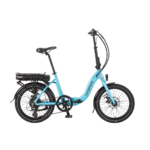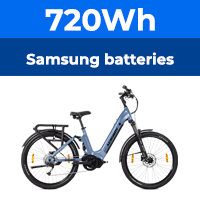Well I hope this really is some sort of breakthrough, however, I doubt very much they are using some new or radically different technology to all the other E-bike batteries available today and we know the effects of storing these in their 'flat' state. Still it looks like it's working OK...Not necessarily - it does depend entirely on the exact technology used.
Back in the days of early NiCds they were always supplied flat - not a peep out of them until they'd been charged for the first time.
If these new batteries are designed to be stored flat so much the better - it makes for a long stress-free shelf life, and also means that you probably don't need to bother 'looking after' them over the winter if you're not riding. Also it's a much safer bet while they're being stored and transported in bulk if there isn't a huge concentrated stored energy 'bomb' being moved around.
I would suggest that might be looked on as 'progress'!
It doesn't sound as though any harm has come to it though, in view of the time taken to charge it - certainly no loss of capacity. Maybe subsequent charges might be a good deal quicker now the battery has been woken up. No doubt 10mph will let us know about those subsequent charges. After all, that's what really matters, not the first charge.
Rog.
Waiting for the intial charge to finish.....(18Ah Kalkhoff battery)
- Thread starter 10mph
- Start date
As the battery is only a couple of months old I personally would be satisfied that all's well. AFAIK none of the modern batteries would run flat in such a short time if not charged.
It's interesting though. If all is as it seems that represents quite a breakthrough in lithium technology. It's not all about capacity, weight and maximum discharge rate.
Rog.
It's interesting though. If all is as it seems that represents quite a breakthrough in lithium technology. It's not all about capacity, weight and maximum discharge rate.
Rog.
Indeed, they all pall into insignificance compared to the price.It's not all about capacity, weight and maximum discharge rate.
Rog.
.
Aha, Flecc, I think we're all painfully aware of that!
It does work in favour of the retailers IMO too. A psychological thing. When the battery gives out it's very, very tempting to buy a new bike rather than replacing the battery, even though, if the bike is half decent the latter would still be the most cost-effective option.
Rog.
It does work in favour of the retailers IMO too. A psychological thing. When the battery gives out it's very, very tempting to buy a new bike rather than replacing the battery, even though, if the bike is half decent the latter would still be the most cost-effective option.
Rog.
2nd Charge
The second charge took 8 hours 45 mins. 3 hours 30 mins quicker than the initial charge.

Part of the time saving was because I put the battery on charge shortly after the first battery light started to flash. At this point according to the manual there is still 10% left in the battery.
Also the time to finish the charging at the fully charged end (the last two bars on the chart above) was about an hour shorter.
One interpretation of these results is that the new battery arrived in a very deeply discharged state. I recall that on the first charge I was initially quite perplexed that when I plugged the battery in there was no LED illuminated or flashing. I got my mains watt meter and plugged the charger in to it. Initially it showed 49 watts being taken from the mains. So I assumed something must be happening, and sure enough after a few minutes I detected a short LED flash every 1 to 2 minutes. Within about 20 minutes the first LED started normal flashing at about once a second. During this period the charger mains power gradually increased from 49 watts to 67 watts.
You can see from the chart that the amount of charge that went in during that red bar, when the first LED was flashing, was more than the charge for one of the nominal 20% bars with the battery more charged. In fact if you scale by saying 8h 44m is 18Ah, that initial 2h 40m would be equivalent to more than 30% of the capacity rather than 20%.
So the charging period is now roughly the same as a working day. However, I got 35 miles in the high power setting on a deliberately chosen hilly route yesterday, and clearly a 70 mile round trip commute would be out of the question on time grounds, although the bike & battery could achieve it.
The charging time is certainly not going to give me any problems at all. My legs are still sufficiently tired today after my comfortable ride of 3 hrs 40 mins yesterday that I feel no inclination to take lengthy exercise more than 24 hours later. In fact my I shall not be repeating my attempt to discharge in the max power mode. I am planning a gentler set of outings over the next few days and I will experiment with lower power settings as much as possible. I will report back on range achieved in due course, although such range reports are of limited value. I wish I had a dynanometer to put the bike on, although, and this is the snag with characterising these Panasonic pedelecs, I would not want to sit on the thing for 4 hours+ pedalling to make the servo provide the power to the wheel.
The second charge took 8 hours 45 mins. 3 hours 30 mins quicker than the initial charge.

Part of the time saving was because I put the battery on charge shortly after the first battery light started to flash. At this point according to the manual there is still 10% left in the battery.
Also the time to finish the charging at the fully charged end (the last two bars on the chart above) was about an hour shorter.
One interpretation of these results is that the new battery arrived in a very deeply discharged state. I recall that on the first charge I was initially quite perplexed that when I plugged the battery in there was no LED illuminated or flashing. I got my mains watt meter and plugged the charger in to it. Initially it showed 49 watts being taken from the mains. So I assumed something must be happening, and sure enough after a few minutes I detected a short LED flash every 1 to 2 minutes. Within about 20 minutes the first LED started normal flashing at about once a second. During this period the charger mains power gradually increased from 49 watts to 67 watts.
You can see from the chart that the amount of charge that went in during that red bar, when the first LED was flashing, was more than the charge for one of the nominal 20% bars with the battery more charged. In fact if you scale by saying 8h 44m is 18Ah, that initial 2h 40m would be equivalent to more than 30% of the capacity rather than 20%.
So the charging period is now roughly the same as a working day. However, I got 35 miles in the high power setting on a deliberately chosen hilly route yesterday, and clearly a 70 mile round trip commute would be out of the question on time grounds, although the bike & battery could achieve it.
The charging time is certainly not going to give me any problems at all. My legs are still sufficiently tired today after my comfortable ride of 3 hrs 40 mins yesterday that I feel no inclination to take lengthy exercise more than 24 hours later. In fact my I shall not be repeating my attempt to discharge in the max power mode. I am planning a gentler set of outings over the next few days and I will experiment with lower power settings as much as possible. I will report back on range achieved in due course, although such range reports are of limited value. I wish I had a dynanometer to put the bike on, although, and this is the snag with characterising these Panasonic pedelecs, I would not want to sit on the thing for 4 hours+ pedalling to make the servo provide the power to the wheel.
Last edited:
I've noticed that all these lithium batteries seem to take disproportionally longer on the first charge from new.
Without knowing the initial content it's impossible to quantify accurately, but as a generalisation about 20% longer seems common. My guess is that it's due to the extra time taken for the newly assembled electrolyte to gain equalised charge throughout the cell content, as well as between the cells under management.
The thought is that gradual redistribution of charge could be occurring in each cell's high density electrolyte, possibly making the BMS return to cell charge redistribution repeatedly. Once the electrolyte charge content had been "evened out", that wouldn't have to happen again.
.
Without knowing the initial content it's impossible to quantify accurately, but as a generalisation about 20% longer seems common. My guess is that it's due to the extra time taken for the newly assembled electrolyte to gain equalised charge throughout the cell content, as well as between the cells under management.
The thought is that gradual redistribution of charge could be occurring in each cell's high density electrolyte, possibly making the BMS return to cell charge redistribution repeatedly. Once the electrolyte charge content had been "evened out", that wouldn't have to happen again.
.
proper maintenance of a lithium-based battery, it’s important to keep the electrons in it moving occasionally. Be sure to go through at least one charge cycle per month (charging the battery to 100% and then completely running it down).
What is the proper way to maintain your lithium ion based battery? Keep it fully charged or let it run down occasionally?
What about keeping it in optimum condition during the winter months when the system is lass likely to be used?
I know that temperature has a significant influence on performance but has it any affect on the battery when not in use?
What about keeping it in optimum condition during the winter months when the system is lass likely to be used?
I know that temperature has a significant influence on performance but has it any affect on the battery when not in use?
I think this is taken from the article which is titled, How to Damage your Lithium Based Battery. This procedure should be strictly followed in order to minimise battery life.proper maintenance of a lithium-based battery, it’s important to keep the electrons in it moving occasionally. Be sure to go through at least one charge cycle per month (charging the battery to 100% and then completely running it down).
Never knowingly run a lithium battery down without good reason such as meter calibration.
They are best "cycle" charged, i.e: topped up regularly to keep them fairly full.
The only battery technologies on e-bikes that benefit from running down to empty are NiCad and NiMh, keep lithium and lead acid topped up.
.
They are best "cycle" charged, i.e: topped up regularly to keep them fairly full.
The only battery technologies on e-bikes that benefit from running down to empty are NiCad and NiMh, keep lithium and lead acid topped up.
.
Does anyone have any solid information as no one seems to agree. I just use my battery and will do untill it stops. Not bothered about maintaining it as i use it alot for work. Don't keep detailed information just make sure the watt meter doesn't show any strange sign's. I'll be happy to get two years out of it and then buy a new one when it's range is crippled by my abuse. For a push bike there cheap, an getting cheaper and better all the time so i don't worry about it.
How to discharge a battery in the workshop?
I know I am supposed to be riding the bike to discharge the battery, especially for the second discharge which I am now carrying out, when I understand I should discharge until the last light flashes rapidly. I will of course be riding it over the next few days. However, it occurs to me it would be handy to have a resistive load which I could place across the battery terminals, in order to perform especially the last bit of discharge in the workshop rather than when out on the road trying to do a job, and have the bike run out in the middle of it.
I could get some resistance wire such as this on ebay, a firebar element, and fashion from it a load which will take say 5 amps at 25volts, and so give me roughly 3 hrs 40 minutes to discharge a full 18Ah, much the same as my real ride on Saturday.
Is there a source for a socket which will take the Kalkhoff/Panasonic type of battery connectors?
Another advantage of making such a device is that by monitoring current and voltage, I could check the absolute battery capacity in Ah, as well as the volatges that the various LEDs switch, and also plot out the overall charge /voltage graph.
I know I am supposed to be riding the bike to discharge the battery, especially for the second discharge which I am now carrying out, when I understand I should discharge until the last light flashes rapidly. I will of course be riding it over the next few days. However, it occurs to me it would be handy to have a resistive load which I could place across the battery terminals, in order to perform especially the last bit of discharge in the workshop rather than when out on the road trying to do a job, and have the bike run out in the middle of it.
I could get some resistance wire such as this on ebay, a firebar element, and fashion from it a load which will take say 5 amps at 25volts, and so give me roughly 3 hrs 40 minutes to discharge a full 18Ah, much the same as my real ride on Saturday.
Is there a source for a socket which will take the Kalkhoff/Panasonic type of battery connectors?
Another advantage of making such a device is that by monitoring current and voltage, I could check the absolute battery capacity in Ah, as well as the volatges that the various LEDs switch, and also plot out the overall charge /voltage graph.
Be carefull, the LVC may well be set in the controller and not in the BMS....I'm not sure where its located on the Panasonic system. If theres a voltage present on the battery terminals even though its 'flat' the LVC is probably in the controller....
Thanks- that is a very useful warning. I think I should ride till cut off during this second discharge and then check the battery terminal voltage as you suggest.Be carefull, the LVC may well be set in the controller and not in the BMS....I'm not sure where its located on the Panasonic system. If theres a voltage present on the battery terminals even though its 'flat' the LVC is probably in the controller....
Hi
10 mph
The reason it is recommended to charge discharge is to balance out the cells voltage
you have a nice new bike ride it and enjoy
WHY are you talking about testing battery if you mess with it you will invalidate the warranty it is what it is If it don't do what it was sold to you to do return it and get a refund
Frank
10 mph
The reason it is recommended to charge discharge is to balance out the cells voltage
you have a nice new bike ride it and enjoy
WHY are you talking about testing battery if you mess with it you will invalidate the warranty it is what it is If it don't do what it was sold to you to do return it and get a refund
Frank
It's as I gave it just above your post. Just start a new lithium battery with one or two full charge/discharge cysles and thereafter charge frequently. For a more detailed account, see the Battery University page below:Does anyone have any solid information as no one seems to agree.
How to prolong lithium battery life
Like you though, I just use in the way most convenient to me and buy a new one when one packs up.
.
When will my battery run out?
Now I am getting rather tired running the battery fully down on its second discharge.
Over the last few days I have done 63 miles position 1 assist (minimum). The 1st LED on the handlebars started flashing at 60 miles. The 1st LED on the battery was still steady when I put the bike away last night. This morning it was also flashing when I got the bike out and tested the battery. So I thought about 10% range left according to the manual. 63/0.9 = 70 miles and then it should run out.
So I set off at 0630 with the sun just rising, temperature= 6.5C, expecting to ride 9 miles to cut out. I did 15 miles before I got fed up and had breakfast.
I have the impression there is less assist, or may be my legs are just worn out after all this cycling day after day. I really need a few days off to let them fully recover. There is still some assist since when I switch off it is a bit harder, so I must soldier on to discharge this battery.
Of course I could just put the assist on the max, level 3, and find a hill to empty it on, but I am interested in determining the maximum range for my riding in the low assist mode. Weight: 95Kg, speed: I dont go much above 11 mph except downhill, terrain: mostly pretty flat with slopes less than 2%. Distance so far on my second charge 78 miles which works out to 5.8 Wh/mile or less depending how much further to discharge the battery, and assuming the full discharge is 453 Wh as inscribed on the battery label.
The manual says the handle bar indicator will flash rapidly near cut off, and Flecc says in his article that at this point I can regard the battery as effectively discharged to as low as I need go. Only then should I commence my third charge up.
Now I am getting rather tired running the battery fully down on its second discharge.
Over the last few days I have done 63 miles position 1 assist (minimum). The 1st LED on the handlebars started flashing at 60 miles. The 1st LED on the battery was still steady when I put the bike away last night. This morning it was also flashing when I got the bike out and tested the battery. So I thought about 10% range left according to the manual. 63/0.9 = 70 miles and then it should run out.
So I set off at 0630 with the sun just rising, temperature= 6.5C, expecting to ride 9 miles to cut out. I did 15 miles before I got fed up and had breakfast.
I have the impression there is less assist, or may be my legs are just worn out after all this cycling day after day. I really need a few days off to let them fully recover. There is still some assist since when I switch off it is a bit harder, so I must soldier on to discharge this battery.
Of course I could just put the assist on the max, level 3, and find a hill to empty it on, but I am interested in determining the maximum range for my riding in the low assist mode. Weight: 95Kg, speed: I dont go much above 11 mph except downhill, terrain: mostly pretty flat with slopes less than 2%. Distance so far on my second charge 78 miles which works out to 5.8 Wh/mile or less depending how much further to discharge the battery, and assuming the full discharge is 453 Wh as inscribed on the battery label.
The manual says the handle bar indicator will flash rapidly near cut off, and Flecc says in his article that at this point I can regard the battery as effectively discharged to as low as I need go. Only then should I commence my third charge up.
Last edited:
Related Articles
-
 MTF Enterprises announces acquisition of EMU Electric Bikes
MTF Enterprises announces acquisition of EMU Electric Bikes- Started by: Pedelecs
-
 Wisper 806T folding bike wins Which? ‘Best Buy’
Wisper 806T folding bike wins Which? ‘Best Buy’- Started by: Pedelecs
-
 Sustrans calls for protected cycle lanes
Sustrans calls for protected cycle lanes- Started by: Pedelecs
-
 Amazon launch their first UK e-cargo micromobility hub
Amazon launch their first UK e-cargo micromobility hub- Started by: Pedelecs



